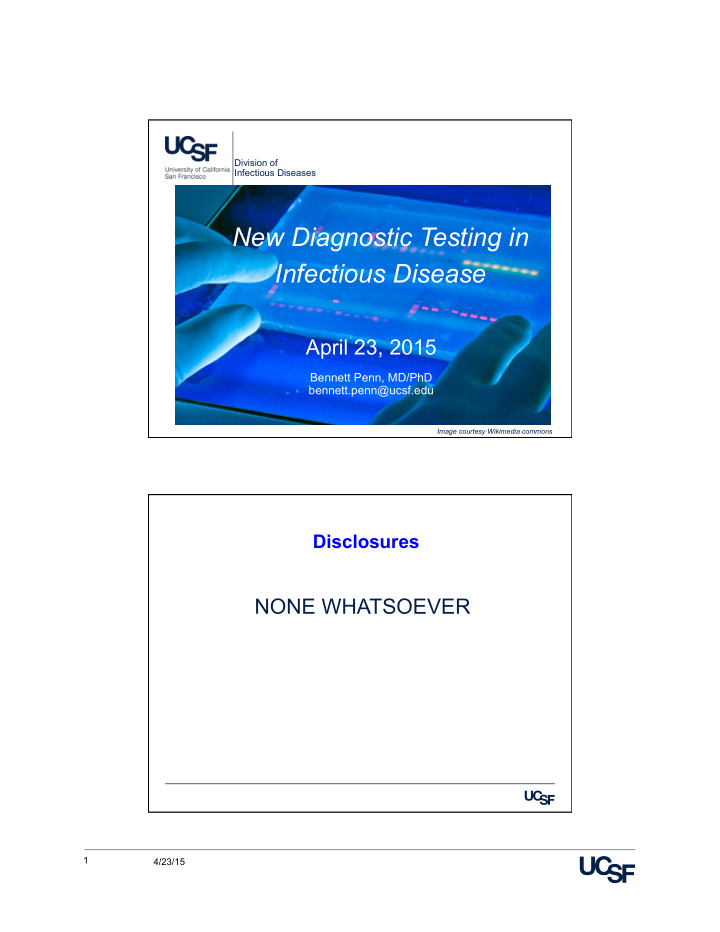



Division of Infectious Diseases New Diagnostic Testing in Infectious Disease April 23, 2015 Bennett Penn, MD/PhD bennett.penn@ucsf.edu Image courtesy Wikimedia commons Disclosures NONE WHATSOEVER 1 4/23/15
Goals: 1) Understand the basic technology 2) Understand advantages/shortcomings of the molecular diagnostics ready for use in primary care setting 3) Understand some of the new technologies becoming available in specialized labs (not ready for widespread use) NOT 1) Comprehensive description of every technology or product on market 2) Endorsement of any particular approach or product 2 4/23/15
NOT 1) MALDI-TOF Mass Spectrometry for blood- culture ID’s 2) PCR for blood-culture ID’s 3) Rapid sensitivity testing for blood cultures 4) PCR-MRI for candidemia Case 1 (common but utterly fictional) 27 y/o female, unremarkable PMH presenting to your ER in Oct with 2d fever 101, HA, photophobia. VS WNL; Exam pt in mild discomfort from HA, somewhat stiff neck, otherwise normal. WBC 10, otherwise nl CBC, Chem. LP: 159 WBC (60% PMN, 40% Lymph) Protein 618 , Glucose 55 You would: A) Admit, start Ceftriaxone, Vancomycin, +/- steroids B) Admit, start Acyclovir, request HSV PCR (2-day turnaround) C) A+B D) Send home 3 4/23/15
Case 2 (quite real) 55 y/o Chinese man who developed ALL. With first chemo, severe pan- colitis. Resolves everywhere except at ileocecal junction where persists despite several months oral abx (Cipro, Flagyl, Augmentin). Developed a fistula which is resected. Felt by surgeons to be non-infx, no cultures. Path shows granulomas -> +AFB on stain. BMT planned for 1-2 mos You would: A) Treat him for TB (INH, RIF, EMB, PZA) B) Treat him for MAC (Azithro, EMB, RIF) C) Treat him for every AFB you can think of (A+B+Aminoglycoside +Imipenem) D) Recommend a second surgery hoping to get micro sample Molecular Diagnostics in ID Offer Multiple Advantages 1) Identify unculturable organisms (viruses, certain bacteria) 2) Identify organisms not isolated (often prior antibiotics) 3) Rapidly identify organisms that grow slowly (TB) 4) Point-of-care testing (?) 4 4/23/15
A Brief Word About the Technologies Ø Most techniques rely on detection of DNA/RNA from pathogen Ø Workhorse for this is Polymerase Chain Reaction (PCR) Heat DNA, Annealing of designed primers Repeat 30-40 times Thermostable polymerase Things to Notice About PCR: Only need to know tiny part of sequence Specific Sequence In middle Massive amplification: (~Trillion-fold) 5 4/23/15
Multiplexing Fluorescent chemical probes can be used to detect different PCR products * Can do 5-10 sensors in same tube * Image courtesy pubzi.com PCR Evolution Images courtesy Wikimedia commons; clker.com; pixgood.com 6 4/23/15
FDA Approved Tests 160+ PCR-based Tests Ø Gonorrhea, Chlamydia (since 1996!) Ø Influenza, RSV, Adenovirus, numerous other respiratory viruses Ø C. Dif Ø HSV-1,2 Ø Enterovirus Ø TB Ø Panels of respiratory pathogens (viruses + bacteria) Ø Panels of bacteria in blood cultures Ø Panels of bacteria in GI infections Full list at: http://www.fda.gov/Medical Devices/ProductsandMedicalProcedures/InVitroDiagnostics/ ucm330711.htm#microbial Does All This Stuff Actually Work? Boehme et al NEJM 2010 7 4/23/15
Recommend
More recommend